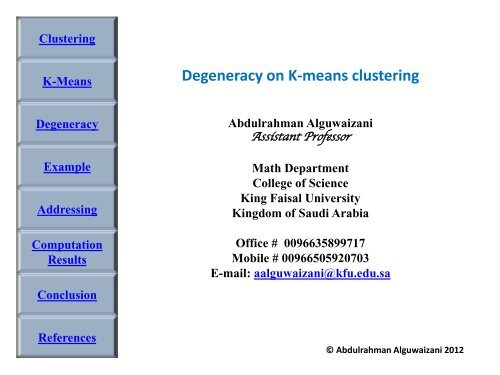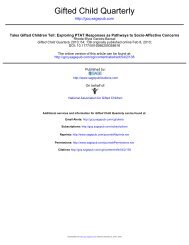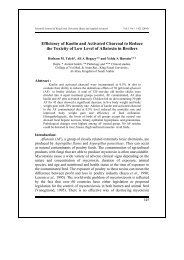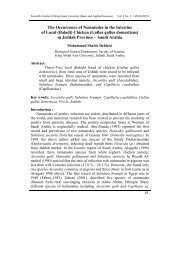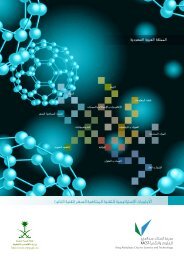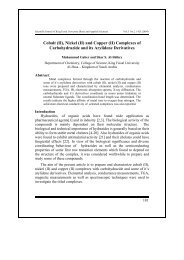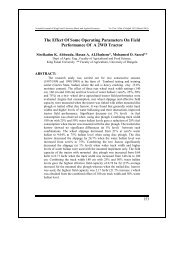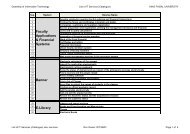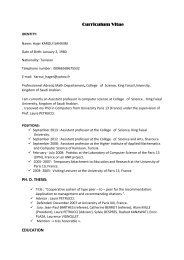Degeneracy on K-means clustering
Degeneracy on K-means clustering
Degeneracy on K-means clustering
Create successful ePaper yourself
Turn your PDF publications into a flip-book with our unique Google optimized e-Paper software.
Clustering<br />
K-Means<br />
<str<strong>on</strong>g>Degeneracy</str<strong>on</strong>g> <strong>on</strong> K-<strong>means</strong> <strong>clustering</strong><br />
<str<strong>on</strong>g>Degeneracy</str<strong>on</strong>g><br />
Example<br />
Addressing<br />
Computati<strong>on</strong><br />
Results<br />
C<strong>on</strong>clusi<strong>on</strong><br />
Abdulrahman Alguwaizani<br />
Assistant Professor<br />
Math Department<br />
College of Science<br />
King Faisal University<br />
Kingdom of Saudi Arabia<br />
Office # 0096635899717<br />
Mobile # 00966505920703<br />
E-mail: aalguwaizani@kfu.edu.sa<br />
References<br />
© Abdulrahman Alguwaizani 2012
Clustering<br />
K-Means<br />
<str<strong>on</strong>g>Degeneracy</str<strong>on</strong>g><br />
Example<br />
DEFINITION:<br />
Clustering is a scientific method which addresses the<br />
following very general problem: given the data <strong>on</strong> a set of entities,<br />
find clusters, or groups of these entities, which are both homogeneous<br />
and well-separated. Homogeneity <strong>means</strong> that the entities in the same<br />
cluster should resemble <strong>on</strong>e another. Separati<strong>on</strong> <strong>means</strong> that entities in<br />
different clusters should differ from <strong>on</strong>e another.<br />
Addressing<br />
Computati<strong>on</strong><br />
Results<br />
C<strong>on</strong>clusi<strong>on</strong><br />
References<br />
© Abdulrahman Alguwaizani 2012
Clustering<br />
K-Means<br />
<str<strong>on</strong>g>Degeneracy</str<strong>on</strong>g><br />
Example<br />
Addressing<br />
Computati<strong>on</strong><br />
Results<br />
C<strong>on</strong>clusi<strong>on</strong><br />
The growth of publicati<strong>on</strong>s <strong>on</strong> <strong>clustering</strong>.<br />
References<br />
© Abdulrahman Alguwaizani 2012
Clustering<br />
K-Means<br />
<str<strong>on</strong>g>Degeneracy</str<strong>on</strong>g><br />
Example<br />
CLUSTERING METHODS:<br />
1. HIERARCHICAL CLUSTERING:<br />
• Agglomerative Hierarchical Clustering.<br />
• Divisive Hierarchical Clustering.<br />
Let δ(C1,C2) be the distance functi<strong>on</strong> between two clusters C1 and<br />
C2. It can be computed as:<br />
Addressing<br />
Computati<strong>on</strong><br />
Results<br />
C<strong>on</strong>clusi<strong>on</strong><br />
References<br />
© Abdulrahman Alguwaizani 2012
Clustering<br />
K-Means<br />
<str<strong>on</strong>g>Degeneracy</str<strong>on</strong>g><br />
Example<br />
Addressing<br />
Computati<strong>on</strong><br />
Results<br />
C<strong>on</strong>clusi<strong>on</strong><br />
References<br />
Example:<br />
C<strong>on</strong>sider the Table<br />
which shows the<br />
distances in miles<br />
between some United<br />
States cities . The<br />
method of <strong>clustering</strong> is<br />
single linkage. So, in<br />
the first stage BOS and<br />
NY are merged into a<br />
new cluster because<br />
206 is the minimum<br />
distance. After<br />
applying the<br />
agglomerative<br />
algorithm, the rest of<br />
the soluti<strong>on</strong> can easily<br />
be c<strong>on</strong>cluded from the<br />
dendrogram in Figure<br />
© Abdulrahman Alguwaizani 2012
Clustering<br />
2. PARTITIONING:<br />
K-Means<br />
<str<strong>on</strong>g>Degeneracy</str<strong>on</strong>g><br />
Example<br />
Addressing<br />
Computati<strong>on</strong><br />
Results<br />
C<strong>on</strong>clusi<strong>on</strong><br />
References<br />
© Abdulrahman Alguwaizani 2012
Clustering<br />
K-Means<br />
<str<strong>on</strong>g>Degeneracy</str<strong>on</strong>g><br />
Example<br />
Addressing<br />
Minimun Sum of Squares Clustering (MSSC):<br />
c<strong>on</strong>sider a set X = x 1 , … , x i , … , x N , x i = x 1i , … , x qi<br />
of N entities in Euclidean space R q . The MSSC problem is to find a<br />
partiti<strong>on</strong> of X into K disjoint subsets C j such that the sum of squared<br />
distances from each entity x i to the centroid<br />
c j of its cluster C j is the minimum.<br />
Specifically, let P K denote the set of all partiti<strong>on</strong>s of X into K sets.<br />
Let partiti<strong>on</strong> P be defined<br />
as P = {C1, C2, … , CK}.<br />
Then MSSC can be expressed as:<br />
Computati<strong>on</strong><br />
Results<br />
where the centroid of cluster j is given as:<br />
C<strong>on</strong>clusi<strong>on</strong><br />
References<br />
© Abdulrahman Alguwaizani 2012
Clustering<br />
K-Means<br />
<str<strong>on</strong>g>Degeneracy</str<strong>on</strong>g><br />
Example<br />
Addressing<br />
Computati<strong>on</strong><br />
Results<br />
C<strong>on</strong>clusi<strong>on</strong><br />
References<br />
© Abdulrahman Alguwaizani 2012
Clustering<br />
K-Means Algorithm:<br />
K-Means<br />
<str<strong>on</strong>g>Degeneracy</str<strong>on</strong>g><br />
Example<br />
Addressing<br />
Computati<strong>on</strong><br />
Results<br />
C<strong>on</strong>clusi<strong>on</strong><br />
References<br />
© Abdulrahman Alguwaizani 2012
Clustering<br />
K-Means<br />
<str<strong>on</strong>g>Degeneracy</str<strong>on</strong>g><br />
Example<br />
Addressing<br />
Computati<strong>on</strong><br />
Results<br />
<str<strong>on</strong>g>Degeneracy</str<strong>on</strong>g> of K-<strong>means</strong> <strong>clustering</strong>:<br />
It has been observed that the final soluti<strong>on</strong> of MSSC problem obtained<br />
by KM heuristic depends substantially <strong>on</strong> the initial choice of<br />
centroids. Since most of these algorithms generate random<br />
initializati<strong>on</strong>s for centroids, the degeneracy could occur with those of<br />
bad initials or choices.<br />
<str<strong>on</strong>g>Degeneracy</str<strong>on</strong>g>:<br />
We say that soluti<strong>on</strong> of the <strong>clustering</strong> problem is degenerate,<br />
if either: (i) there is <strong>on</strong>e or more cluster centers have no entities<br />
allocated to them or (ii) two or more cluster centers are identical.<br />
Degree of <str<strong>on</strong>g>Degeneracy</str<strong>on</strong>g>:<br />
We say that degenerate soluti<strong>on</strong> has degree of degeneracy<br />
equal to d if the number of empty clusters in the soluti<strong>on</strong> is equal to d.<br />
C<strong>on</strong>clusi<strong>on</strong><br />
References<br />
© Abdulrahman Alguwaizani 2012
Clustering<br />
K-Means<br />
<str<strong>on</strong>g>Degeneracy</str<strong>on</strong>g><br />
Example<br />
Addressing<br />
Initializati<strong>on</strong>:<br />
initial cluster centers are<br />
located at customer<br />
locati<strong>on</strong>s 75, 63 and 65<br />
when 3 clusters are<br />
desired.<br />
If K = 4, the same initial<br />
soluti<strong>on</strong> is suggested in<br />
additi<strong>on</strong> to locati<strong>on</strong> 61<br />
for the fourth cluster.<br />
Computati<strong>on</strong><br />
Results<br />
C<strong>on</strong>clusi<strong>on</strong><br />
References<br />
© Abdulrahman Alguwaizani 2012
Clustering<br />
K-Means<br />
<str<strong>on</strong>g>Degeneracy</str<strong>on</strong>g><br />
Example<br />
Addressing<br />
Computati<strong>on</strong><br />
Results<br />
C<strong>on</strong>clusi<strong>on</strong><br />
References<br />
© Abdulrahman Alguwaizani 2012
Clustering Functi<strong>on</strong> KMDEG (C, K, C, Maxit, N, C, z )<br />
1. C (new) = {c 1 , c 2 , … , c K } K centroids are chosen from X.<br />
K-Means<br />
<str<strong>on</strong>g>Degeneracy</str<strong>on</strong>g><br />
Example<br />
Addressing<br />
Computati<strong>on</strong><br />
Results<br />
2. i ← 0 i-iterati<strong>on</strong> counter<br />
3. repeat<br />
4. i ← i + 1<br />
5. C ← C (new)<br />
6. z = f MSSC (C)<br />
7. Indicate indices b l of degenerate soluti<strong>on</strong>s (l = 1, . . . , g)<br />
8. if g > 0 then<br />
9. for l ∶= 1, … , g do<br />
10. t = b l<br />
11. h = 1 + n ∗ RND choose an entity h at random<br />
12. for β ≔ 1, … , q do<br />
13. c tβ = x hβ<br />
14. until z does not change or i = Maxit<br />
C<strong>on</strong>clusi<strong>on</strong><br />
References<br />
© Abdulrahman Alguwaizani 2012
Clustering<br />
K-Means<br />
<str<strong>on</strong>g>Degeneracy</str<strong>on</strong>g><br />
Example<br />
Addressing<br />
Computati<strong>on</strong><br />
Results<br />
C<strong>on</strong>clusi<strong>on</strong><br />
References<br />
© Abdulrahman Alguwaizani 2012
Clustering<br />
K-Means<br />
<str<strong>on</strong>g>Degeneracy</str<strong>on</strong>g><br />
Example<br />
Addressing<br />
Computati<strong>on</strong><br />
Results<br />
C<strong>on</strong>clusi<strong>on</strong>:<br />
The Minimum Sum Of Squares Clustering (MSSC) problem is<br />
c<strong>on</strong>sidered and the algorithm (KM) is designed to solve it. It has been<br />
observed that the K-Means (KM) <strong>clustering</strong> heuristic for solving<br />
(MSSC) poses the property of degeneracy, i.e., the property that some<br />
clusters could remain empty (without entities) during the executi<strong>on</strong> or<br />
at the code.<br />
I explain the degenerate soluti<strong>on</strong>s and provide an efficient and easy<br />
procedure which removes degeneracy immediately when it appears<br />
in iterati<strong>on</strong>s.<br />
Future work:<br />
• Diagnosing the degeneracy.<br />
• Applying VNS to improve the soluti<strong>on</strong>.<br />
C<strong>on</strong>clusi<strong>on</strong><br />
References<br />
© Abdulrahman Alguwaizani 2012
Clustering<br />
K-Means<br />
<str<strong>on</strong>g>Degeneracy</str<strong>on</strong>g><br />
Example<br />
Addressing<br />
Computati<strong>on</strong><br />
Results<br />
C<strong>on</strong>clusi<strong>on</strong><br />
References<br />
References:<br />
[1] Aloise, D., A. Deshpande, P. Hansen and P. Popat, NP-hardness of<br />
Euclidean sum-of-squares <strong>clustering</strong>, Machine Learning 75 (2009), pp.<br />
245–248.<br />
[2] Aloise, D. and P. Hansen, Clustering, in: Handbook of Discrete and<br />
Combinatorial Mathematics, CRC Press, 2010 .<br />
[3] Blake, C. and C. Merz, UCI repository of machine learning<br />
databases, http://archive.ics.uci.edu/ml/datasets.html (1998),<br />
[Online; accessed Jan 12, 2012].<br />
[4] Brimberg, J. and N. Mladenovi´c, <str<strong>on</strong>g>Degeneracy</str<strong>on</strong>g> in the multi-source<br />
Weber problem, Mathematical Programming 85 (1999), pp. 213–220.<br />
[5] Forgy, E., Cluster analysis of multivariate data: efficiency versus<br />
interpretability of classificati<strong>on</strong>s, Biometrics 21 (1965), pp. 768–769.<br />
[6] Hansen, P. and N. Mladenovi´c, J-<strong>means</strong>: a new local search<br />
heuristic for minimum sum of squares <strong>clustering</strong>, Pattern Recogniti<strong>on</strong><br />
34 (2001), pp. 405– . 413<br />
[7] Kaufman, L. and P. Rousseeuw, “Finding groups in data. An<br />
introducti<strong>on</strong> to cluster analysis”, A JOHN WILEY & SONS INC.<br />
PUBLICATION, 1990.<br />
© Abdulrahman Alguwaizani 2012
Clustering<br />
K-Means<br />
<str<strong>on</strong>g>Degeneracy</str<strong>on</strong>g><br />
Example<br />
Addressing<br />
References:<br />
[8] MacQueen, J., Some methods for classificati<strong>on</strong> and analysis of<br />
multivariate observati<strong>on</strong>s, Berkeley, CA: University of California Press<br />
1 (1967), pp. 281–297.<br />
[9] Mirkin, B., “Clustering for data mining: a data recovery approach,”<br />
Taylor & Francis group, FL, 2005.<br />
[10] Mladenovi´c, N. and J. Brimberg, A degeneracy property in<br />
c<strong>on</strong>tinuous locati<strong>on</strong>-allocati<strong>on</strong> problems, Les Cahiers du GERAD G-96-<br />
37 (1996).<br />
[11] Ruspini, E., Numerical methods for fuzzy <strong>clustering</strong>, Informati<strong>on</strong><br />
Sciences 2(1970), pp. 319–350.<br />
[12] Xu, R. and D. Wunsch, “Clustering,” IEEE Press, 2009.<br />
Computati<strong>on</strong><br />
Results<br />
C<strong>on</strong>clusi<strong>on</strong><br />
References<br />
© Abdulrahman Alguwaizani 2012
Clustering<br />
K-Means<br />
<str<strong>on</strong>g>Degeneracy</str<strong>on</strong>g><br />
Example<br />
Addressing<br />
THANK YOU FOR LISTENING<br />
Computati<strong>on</strong><br />
Results<br />
C<strong>on</strong>clusi<strong>on</strong><br />
References<br />
© Abdulrahman Alguwaizani 2012


